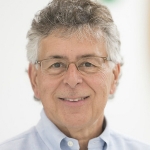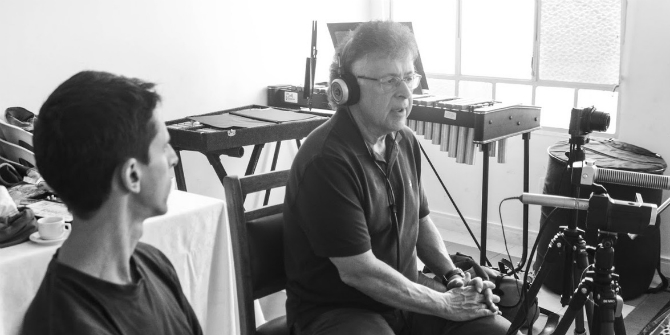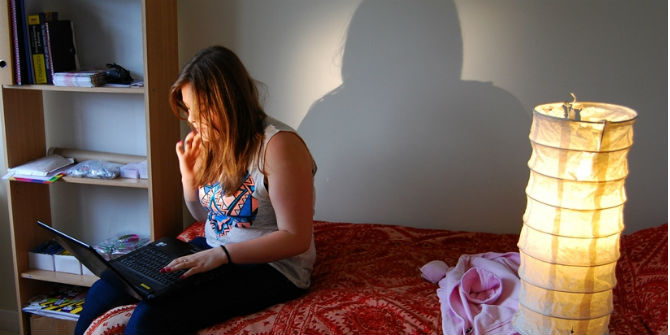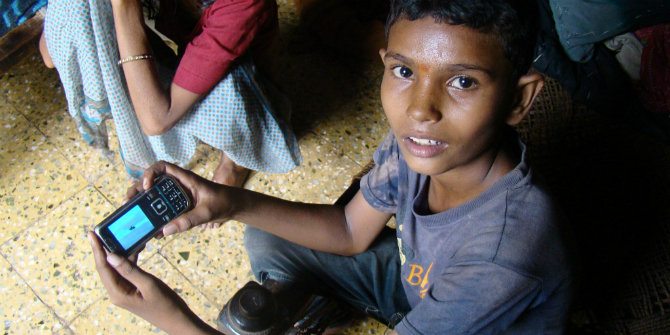 In this post, Howard Blumenthal discusses his new project Kids on Earth, which is an online collection of more than 500 videos of children from around the world talking about how technology has shaped their learning and plans for the future. Howard Blumenthal is a visiting scholar at the University of Pennsylvania. Howard created and produced PBS’s Peabody and Emmy Award winning series about world cultures, Where in the World Is Carmen Sandiego? [Header image credit: B. Fröberg, CC BY 2.0.jpg]
In this post, Howard Blumenthal discusses his new project Kids on Earth, which is an online collection of more than 500 videos of children from around the world talking about how technology has shaped their learning and plans for the future. Howard Blumenthal is a visiting scholar at the University of Pennsylvania. Howard created and produced PBS’s Peabody and Emmy Award winning series about world cultures, Where in the World Is Carmen Sandiego? [Header image credit: B. Fröberg, CC BY 2.0.jpg]
Travelling the world, interviewing children and teenagers, several key ideas become clear. First, school occupies only a portion of the learning landscape. Second, technology opens the world, allowing personal curiosity to become individual learning on a massive scale. Third, young people everywhere use all available resources to dream big and make plans for the future.
In two years, Kids on Earth has become the world’s largest library of one-on-one video interviews with children and teenagers (mostly nine to 14-years-old). Kids on Earth’s constantly expanding Vimeo site presents more than 500 videos recorded in England, Bulgaria, Slovenia, Kosovo, Uganda, Hong Kong, the United States, Brazil, Uruguay, Cambodia, Chile, and elsewhere. Many interviewees also talk about personal connection to other places: Russia, Barbados, Venezuela, Moldova, Turkey, Japan, Georgia, Panama, Sierra Leone, India, Pakistan, more. Future plans include physical or digital visits to Singapore, Bangladesh, India, Namibia, South Africa, Germany, Iran, Israel, and China.

Teachers and curious students watch Kids on Earth videos in more than 50 countries. Often, they gain first exposure to a culture or a nation, and sometimes, a continent. Kids on Earth promotes personal learning on the internet on a massive scale, driven not by curriculum but through curiosity.
Kids on Earth started in Uganda’s capital region, Kampala. The first interviews were eye-opening. Even with limited resources, students in Uganda knew more about the world, and about the United States (where I am based) than I would ever know about their country. They were literate in more than one language, connected to people and information throughout the world, healthy, and living in relative wealth that would have been inconceivable for most of the 20th century. With notable exceptions, literacy, connection, health and relative wealth define 21st century childhood – these themes emerged in a struggling Kentucky coal mining town, a low-income village in rural Bulgaria, and a posh private school outside Manchester, England.
In Kampala, students were convinced education was the magic substance that would allow their generation to banish corruption, and build a modern nation. One young man would travel to England not just to study to become a surgeon, but to return to Uganda to build a hospital.
Markel currently lives in South Charleston, West Virginia, US, but he won’t stick around for long. As soon as Markel turns 18, he’s leaving for Seattle, Washington, where there is far more opportunity. If he doesn’t succeed as an NBA basketball player, he’ll fall back on his interests in cartography and geography, probably mapping planets or asteroids.
Kaia, 12, named for a pizza place outside Pittsburgh, Pennsylvania, also lives in South Charleston. She envisions school’s future with lots of technology, but few teachers.
Nik, from Bristol, England, learns about the world through his own curiosity. School has let him down – he suffered terribly from bullying – but he found himself by making art about kindness and compassion. I met Nik because he is an Anti-Bullying Ambassador for the (Princess) Diana Award. He taught me a great deal (Nik is 11. Nik has met Prince Charles. I have not.)
I hope, and believe, that Teo, 14, who lives in Piran on the Adriatic Coast in Slovenia, will achieve his dream: a career as a theoretical physicist at a major European research university. When Teo showed up for an interview wearing a t-shirt depicting Einstein on electric guitar, I was prepared for an unusual conversation. Most kids his age don’t know much about quantum physics, but Teo does because he has watched every available video on YouTube (better than books because they’re visual, often animated).
If there is a unifying theme between and among these young people, it is ease with learning on their own. School is no longer the arbiter, or best possible provider, of learning for children and teenagers. Kids know that. Adults are slow to pick up on this important aspect of 21st-century thinking.
Rebekah, who lives in the hollers of Eastern Kentucky, is a model of self-awareness. This, too, emerges as a common characteristic – with so much social media exposure, there is ample opportunity to consider your identity, your mark on the world, and your range of opportunities. Rebekah would like to become an actress, but she is candid about the difficult work she must do in order to achieve that dream.
Kristian attends the same school. One minute, he talks about hunting and fishing. The next, Kristian explains why he has ruled out a career as an orthopedic surgeon, opting instead for pharmacology. Self-effacing, Kristian knows a lot. His goals are clear. He understands the challenges of the career path he has chosen. He is 12 years old.
All of these kids use technology, and they know how to use it safely.
Lyric, 13, also lives in West Virginia. She thinks the whole discussion about internet privacy is sort-of ridiculous, but she routinely uses the internet for whatever interests her on that particular day.
In fact, Auksun, 11, from Southport, England is far more engaged with deeper, wilder ideas, such as the brain-mind connection, and artificial intelligence.
Desire for knowledge is common to every young person I’ve met. Many express great respect for teachers, but acknowledge a very broken system of schooling, especially after third or fourth grade. Motivation is intrinsic. And every time I forget curiosity drives learning, children and teenagers around the world remind me.
Vicky, 12, from the small Bulgarian city of Stara Zagora, wants to become a paleontologist because dinosaurs in Sofia’s natural history museum fascinate her. Much of what students learn occurs outside of school. Their learning is greatly expanded by watching videos on YouTube.
In fact, Auksun, 11, from Southport, England is engaged with deeper, wilder ideas, such as the brain-mind connection and artificial intelligence. This came about because of a tech projects curriculum in school, and a great deal of internet exploration, mostly in the game space.
Of course, not all technology is internet or mobile tech. Bozhidara, age 7, lives in a small Bulgarian village with Gypsy/Roma heritage. She will become a paediatrician. And she explains why – medical technology made it possible to see inside her own body, and she was captivated.
And lest we forget that human connections are infinitely more meaningful than our other inventions, Sianni, 14, from outside Philadelphia in the United States brings us back to reality.
What’s been learned? Is this just a bunch of interviews with a diverse range of young people, or something more? As I have begun to speak at various universities around the world, to students and to professors, I find remarkable agreement about how completely the world has changed during the past decade.
We have provided billions of people with a powerful pocket-sized learning machine. From the earliest age, children and now learn what they want, when they want, in the way they want. This alone might change the world, or, at least, the world of learning. When a global connection to information, ideas and people becomes a way of life – as it has for this generation of the world’s children – children’s perceptions of themselves change. They see others dream, so they dream. They see others map a course to success and fulfilment, free from economic strife and hatred, so they plot their own steps. They see faces unlike their own, with different pigmentation and different hair, but they concentrate upon similarities. They see no reason to hate (and associate the idea with past generations), so they accept everyone as equal.
And they learn – quickly, efficiently, effectively, based upon their own designs.
We’re standing at the very start of their future. Imagine the world in 2050 – more than a billion new children and teenagers mostly in Asia and Africa, connected and no longer carrying water from wells, literate in two languages and completing a productive economic future, regardless of gender or family background.
Kids are optimistic. As adults, it’s our job to make their dreams come true.
This post gives the views of the authors and does not represent the position of the LSE Parenting for a Digital Future blog, nor of the London School of Economics and Political Science.





